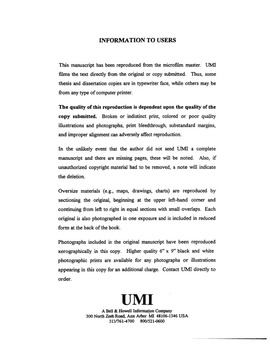| dc.contributor.advisor | Kondonassis, Alex J., | en_US |
| dc.contributor.author | Motii, Bahman. | en_US |
| dc.date.accessioned | 2013-08-16T12:30:23Z | |
| dc.date.available | 2013-08-16T12:30:23Z | |
| dc.date.issued | 1998 | en_US |
| dc.identifier.uri | https://hdl.handle.net/11244/5746 | |
| dc.description.abstract | Embedding input-output characteristics into an econometric specification at regional level has recently gained popularity. The focus of attention has been directed toward the methodology with which the input-output characteristics can be incorporated into an econometric specification. | en_US |
| dc.description.abstract | Although the interdependency of a region's economic sectors through time has gained considerable attention, yet the dynamic properties of the intersectoral relationship has not been fully incorporated into the current integrated models. Moreover, much of the attention has been on the partial interindustry relationship rather than accounting for all economic sectors of a region or state. | en_US |
| dc.description.abstract | This dissertation resulted into a unique integration approach that was used to construct a dynamic integration (DIA) model. While this model, with a better predictive accuracy, accounts for structural change in the economy, it can estimate the values of the region's input-output coefficients through time. | en_US |
| dc.description.abstract | First, regional integration strategies were discussed and a theoretical framework was developed to compare current embedded integration strategies. Second, a dynamic integrated model, DIA, was build upon the theoretical framework. Then alternative model specifications were constructed by using the DIA model, and based on the theoretical framework that was developed. Finally the properties of the DIA were compared with other model specifications. | en_US |
| dc.description.abstract | The purpose of this dissertation was to investigate the implications of integrating inter-sectoral relationships to a state level econometric employment model. The focus of this investigation was on incorporating a dynamic, rather than static, intersectoral relationship into the integrated model. A unique cost adjustment factor (CAF) was constructed to account for dynamic structural change in the region's economy. The study also focused on the inclusion of all major macro economic sectors of the state, rather than partial industries. | en_US |
| dc.description.abstract | The embedding integration approach is classified as embedding-partitive and embedding-holistic. While partitive approach incorporates some selected interindustry relationship into an econometric specification, the holistic approach accounts for total intersectoral demand for output of a sector originating from all industries in a region. | en_US |
| dc.format.extent | ix, 146 leaves ; | en_US |
| dc.subject | Regional economics Econometric models. | en_US |
| dc.subject | Econometric models. | en_US |
| dc.subject | Input-output analysis. | en_US |
| dc.subject | Economics, Theory. | en_US |
| dc.subject | Econometrics. | en_US |
| dc.subject | Economics, General. | en_US |
| dc.subject | Regional economics. | en_US |
| dc.subject | Economics, Commerce-Business. | en_US |
| dc.title | Embedding regional input-output and econometric models: A dynamic integration approach (DIA). | en_US |
| dc.type | Thesis | en_US |
| dc.thesis.degree | Ph.D. | en_US |
| dc.thesis.degreeDiscipline | College of Arts and Sciences | en_US |
| dc.note | Source: Dissertation Abstracts International, Volume: 59-12, Section: A, page: 4495. | en_US |
| dc.note | Major Professor: Alex J. Kondonassis. | en_US |
| ou.identifier | (UMI)AAI9914399 | en_US |
| ou.group | College of Arts and Sciences | |
